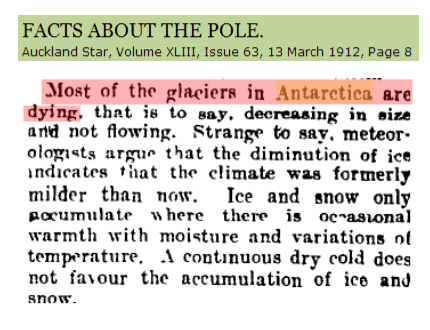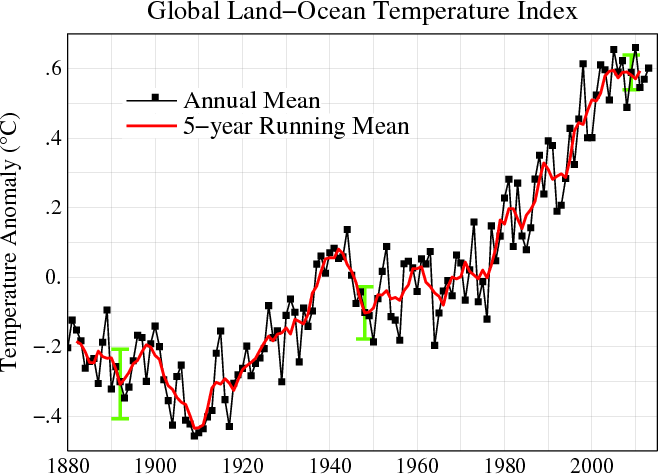Most of the glaciers in Antarctica were shrinking 100 years ago, during NASA’s coldest years ever. At the time, climate experts didn’t lie about it though. They explained that the shrinking glaciers were due to the cold.
Strange to say, meteorologists argue that the diminution of ice indicates that the climate was formerly milder than now. Ice and snow only accumulate where there is occasional warmth with moisture and variations of temperature. A continuous dry cold does not favour the accumulation of ice and snow.
Papers Past — Auckland Star — 13 March 1912 — FACTS ABOUT THE POLE.
Note that according to NASA, this was occurring during the coldest years on record.




History, logic, and the forces and variability of nature have been thrown out the window by the AGW warmists in their cult-like insistence on a hypothesis which is being shown, year after year, to be inaccurate.
The warmists have their minds blocked by the old paradigm (which was a reasonable hypothesis in the 1990’s) and probably will never be able to see the facts in a different perspective.
Even with the temperature rise, Antarctica is not a vacation spot. Anyone with half a brain can see it is still freezing. So the reduction is not due to warming.
There’s no reduction at Antatrctica. The ice is accumulating.
According to GOES, the continent is losing mass. The sea is gaining extent and area. That is the new meme they trot out – omitting the volcanic activity under west Antarctica.
Antarctica is not a vacation spot? Get with the times, Phil, won’t you?
http://www.youtube.com/watch?v=BhMkF2YGq70
Well, between you and me Colorado, my wife likes it cold, so it is for us. But I hate crowds, so I am trying to keep the rubber neckers down! 😉
Because it deserves a reread
http://newsbusters.org/blogs/noel-sheppard/2007/09/09/reports-record-arctic-ice-melt-disgracefully-ignore-history
Oops wrong thread should be under the “Arctic Sea Ice Area Up 55% Since 2012”
Thanks for the link.
The following comment is a historic confirmation that the WWII years were particularly warm at the NP
“Between 1940 and 1942 St. Roch navigated the Northwest Passage, arriving in Halifax harbor on October 11, 1942. St. Roch was the second ship to make the passage, and the first to travel the passage from west to east. In 1944, St. Roch returned to Vancouver via the more northerly route of the Northwest Passage, making her run in 86 days. The epic voyages of St. Roch demonstrated Canadian sovereignty in the Arctic during the difficult wartime years, and extended Canadian control over its vast northern territories.“
as indicated also by the following chart,
http://www.climate4you.com/images/MAAT%2070-90N%20HadCRUT4%20Since1900.gif
Yep, another random google find when looking for something else. 🙂
I got reading it so bookmarked it.
IIRC by the end of the ’40 it’s all iced up again.
You’ll probably like this from the other link – a timeline of seafaring in the Arctic. Its not that complete in the recent years but there’s lots of older stuff.
http://www.south-pole.com/main.html
Go to the ‘Antarctic History’ tab, and on the list is ‘Arctic Time Line’
Thanks, you just have to follow the usual “suspects” AMO, PDO and solar forcing and there you have: the Arctic ice doing cyclic oscillations as anyone else.
It’s perhaps too simple to fit into the academic minds. 🙂
Don’t forget a little Pacific El Nino/nina to stir it up a bit.
Yeah, that beautiful, clear signature of climate change right there in the middle of the Pacific ocean, with its short and long periods, summarizing everything, or perhaps, better, closing the circuit of the other oscillations.
This fascinating read of the history of exploring the Antarctic goes here
http://www.south-pole.com/main.html
It also has a good section on the exploration of the Arctic and the attempts at crossing the NW passage.
It’s all about science really, or the IPCC would have you believe.
Andrei Kapitsa the discoverer of Lake Vostok in the Eastern Antarctic thought so until 1995.
Andrei Kapitsa, a Russian geographer and Antarctic ice core researcher, slammed the UN IPCC as “the biggest ever scientific fraud”. “A large number of critical documents submitted at the 1995 U.N. conference in Madrid vanished without a trace. As a result, the discussion was one-sided and heavily biased, and the U.N. declared global warming to be a scientific fact.”